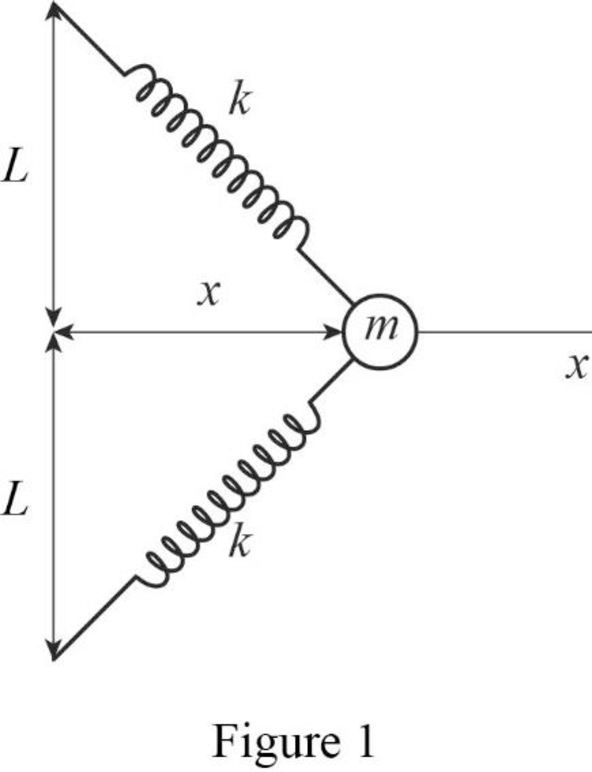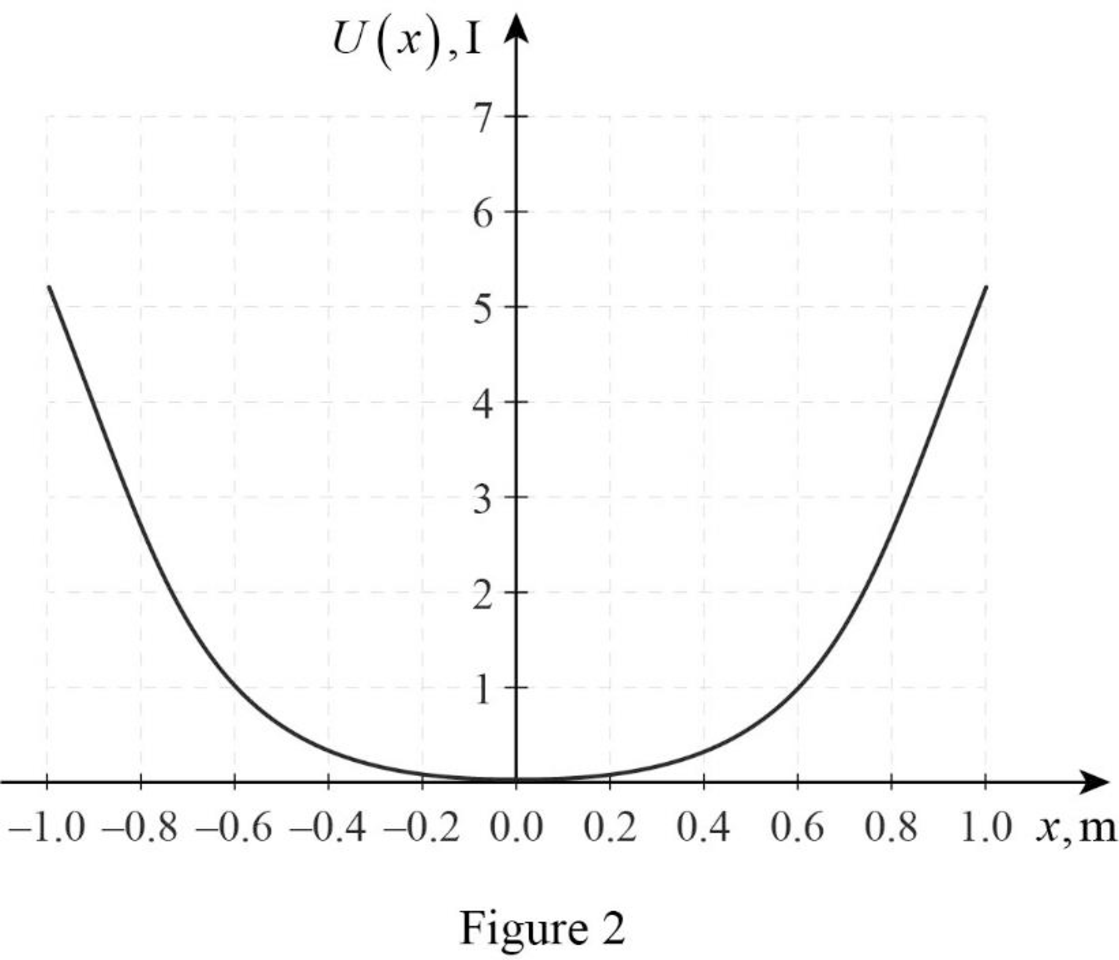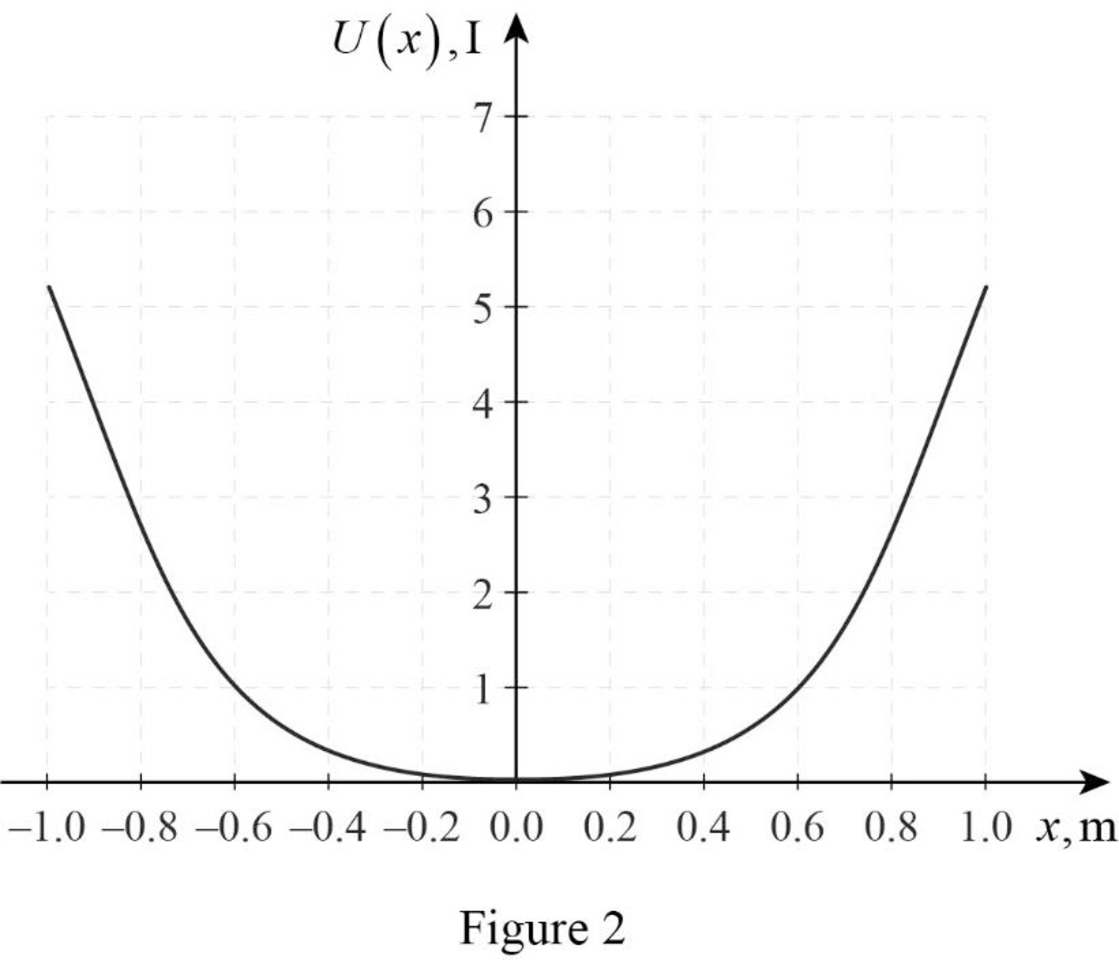
Concept explainers
(a)
To show force exerted by the springs on the particle is
(a)
Answer to Problem 68P
The force exerted by the springs on the particle is shown as
Explanation of Solution
Figure 1 represents two springs attached to mass

Write the expression for force.
Here,
From Figure 1 the new length is given as
Apply the above condition in equation (I).
From Figure 1, the angle cosine of
Use equation (III) in (II).
Conclusion:
Therefore, the force exerted by the springs on the particle is shown as
(b)
To show potential energy of the system is
(b)
Answer to Problem 68P
The potential energy of the system is shown as
Explanation of Solution
From subpart (a) force is
Write the potential energy of the system.
Here,
Use equation (IV) in (V) and Integrate Equation (V) from
Conclusion:
Therefore, the potential energy of the system is shown as
(c)
To make a plot between
(c)
Answer to Problem 68P
The plot between

Explanation of Solution
Figure 1 represents the plot between

Conclusion:
Therefore, The plot between

(d)
The speed of the mass
(d)
Answer to Problem 68P
The speed of the mass
Explanation of Solution
From subpart (b) gravitational potential energy is given as
The speed of the particle is equal to the change in gravitational potential energy.
Rearrange equation (VI), to find
Conclusion:
Substitute
Substitute
Therefore, the speed of the mass
Want to see more full solutions like this?
Chapter 6 Solutions
Bundle: Principles of Physics: A Calculus-Based Text, 5th + WebAssign Printed Access Card for Serway/Jewett's Principles of Physics: A Calculus-Based Text, 5th Edition, Multi-Term
- Mick and Rick are twins born on Earth in the year 2175. Rick grows up to be an Earth-bound robotics technician while Mick becomes an intergalactic astronaut. Mick leaves the Earth on his first space mission in the year 2200 and travels, according to his clock, for 10 years at a speed of 0.75c. Unfortunately, at this point in his journey, the structure of his ship undergoes mechanical breakdown and the ship explodes. How old is Rick when his brother dies?arrow_forwardHi, I have canceled, why did you charge me again?arrow_forwardNo chatgpt pls will upvotearrow_forward
 Principles of Physics: A Calculus-Based TextPhysicsISBN:9781133104261Author:Raymond A. Serway, John W. JewettPublisher:Cengage Learning
Principles of Physics: A Calculus-Based TextPhysicsISBN:9781133104261Author:Raymond A. Serway, John W. JewettPublisher:Cengage Learning Physics for Scientists and Engineers: Foundations...PhysicsISBN:9781133939146Author:Katz, Debora M.Publisher:Cengage Learning
Physics for Scientists and Engineers: Foundations...PhysicsISBN:9781133939146Author:Katz, Debora M.Publisher:Cengage Learning University Physics Volume 1PhysicsISBN:9781938168277Author:William Moebs, Samuel J. Ling, Jeff SannyPublisher:OpenStax - Rice University
University Physics Volume 1PhysicsISBN:9781938168277Author:William Moebs, Samuel J. Ling, Jeff SannyPublisher:OpenStax - Rice University Physics for Scientists and Engineers, Technology ...PhysicsISBN:9781305116399Author:Raymond A. Serway, John W. JewettPublisher:Cengage Learning
Physics for Scientists and Engineers, Technology ...PhysicsISBN:9781305116399Author:Raymond A. Serway, John W. JewettPublisher:Cengage Learning Physics for Scientists and Engineers with Modern ...PhysicsISBN:9781337553292Author:Raymond A. Serway, John W. JewettPublisher:Cengage Learning
Physics for Scientists and Engineers with Modern ...PhysicsISBN:9781337553292Author:Raymond A. Serway, John W. JewettPublisher:Cengage Learning Classical Dynamics of Particles and SystemsPhysicsISBN:9780534408961Author:Stephen T. Thornton, Jerry B. MarionPublisher:Cengage Learning
Classical Dynamics of Particles and SystemsPhysicsISBN:9780534408961Author:Stephen T. Thornton, Jerry B. MarionPublisher:Cengage Learning





